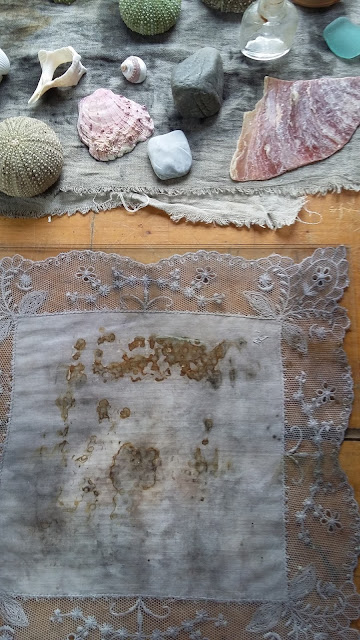results!
 |
| so proper dyeing then, using tara powder and alum premordanting on two previously home-dyed shirts, a vest and two virgin pieces of fabric: an oblong strip of cotton and a lacey handkerchief; all have been pre-mordanted as per instrucions found on the internet; my dyeing expeditions are becoming ever more knowledgable, although they remain rather haphazard at the best of times. To my amazement (and annoyment) I find contradictory advice on the use of the tara powder, one source whilst describing the possibilities of the powder also informs me she doesn't like to use it herself. I stick to what I am able to comprehend and end up using the following recipe: from the Fibre Garden
Tara Powder. This is the ground seed pods* of the tropical plant Caesalpinia spinosa which are naturally high in tannins, up to 50% by dry weight. It's used as a mordant and also to make the "logwood black" dye colour.
Traditionally used mainly on cellulose fibres, as part of a premordant in combination with alum.
TO USE: weight out 15% to weight of fibre EACH of Tara powder and alum. Dissolve alum in hot water and add with water to mordant pot. Add fibre and simmer at 180-200°F for 1 hour. Remove fibre, rinse and spin out excess water. In another pot of water, add the Tara powder (put it into a nylon stocking) and simmer at 180-200°F for one hour: this can be done while the alum pot is simmering. Remove stocking, and place the fibre in the Tara solution then simmer for an hour.** Let cool, then remove fibre, spin out then wash and rinse. Fibre is now ready for dyeing and may be used fresh or dried for later.
Both spent mordant solutions may be safely disposed of down the drain (except for septic systems), or poured around garden plants that prefer acidic soil conditions. ha I like this very much, sounds kind of perma-culturistic, not wasting what I have, although I would be introducing an alien element to the garden. As we have so much clay I'm guessing it is basically alkaline and could do with a bit of acidity.
*reading this I ask self why I didn't do more research before I went and ordered the Tara powder which has come all the way from Peru! as I think I could also have used locally sourced acorns, rich in tannin as well (is it equally high in tannins though??) grinding them and thus making my own tannin-rich solution
** I did not simmer the tara pot on the stove, thought that too wasteful, just left it on the deck in the sun, warm enough I felt
|
I absolutly adore how the handkerchief turned out, I'm not usually a lace lover, but the lightness of the piece delights me, I have nothing to add except a fitting frame; I have placed it between two perfectly sized glass panes and wil ask friend W. to make a narrow frame, much like a leaded glass window.




















Comments
THIS way....yes! and the woad
and
the SHOWER!!!!!!!!!!!!!!!!!!!
All....I WISH i could come over and walk around.....
in the interest of full disclosure: I am at home suffering (yes suffering and not in the office working) from menstrual cramps like never before....at 53 and having skipped several menses I had hoped they would by now be a thing of the past
sorry to hear you suffering the menopause can be a real bitch.
ce of needle lace, it looks hand stitched?
Haha, active cat!
I haven't a clue whether the lace is handstitched or not Mo, how can I tell?? I am guessing it's all cotton as the dye took.
I have madder and japanese indigo seedlings coming up in two separate large containers - I am thinking of just leaving them there until they really do get strong.
Be well xo
am doing much better thx